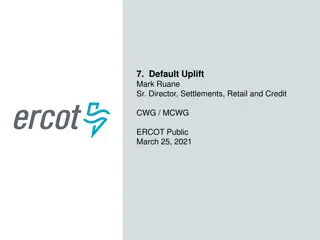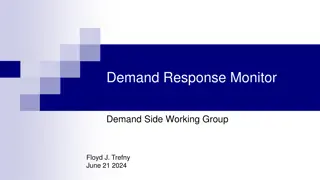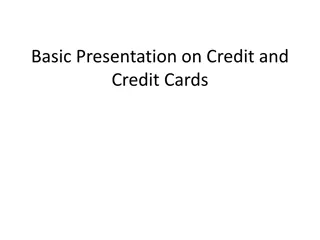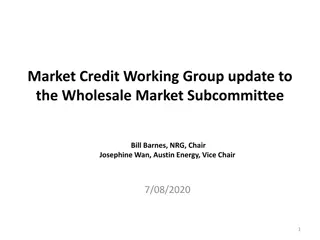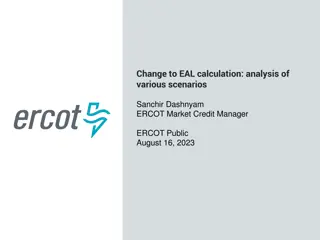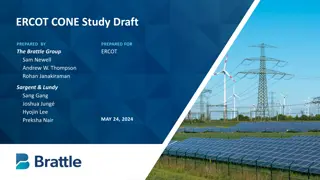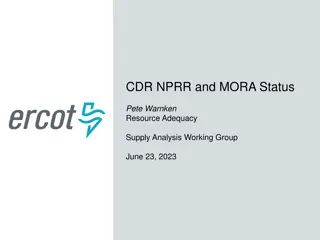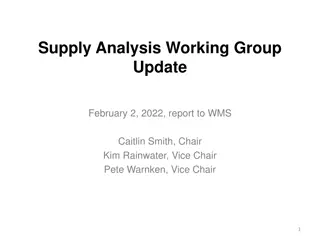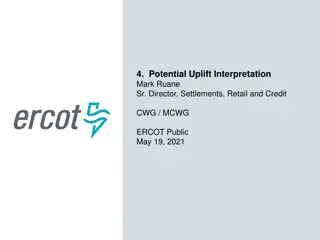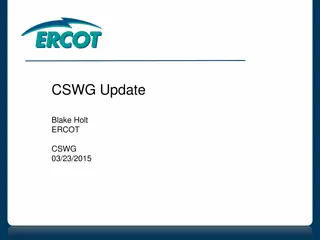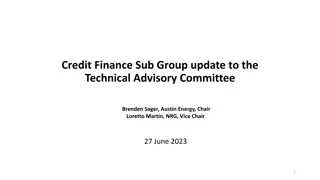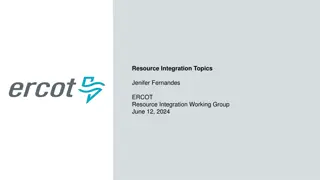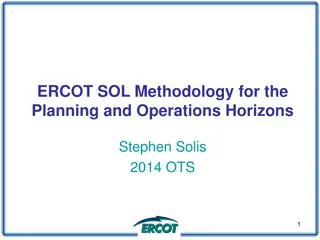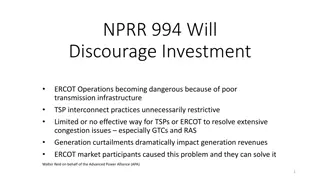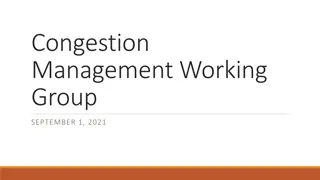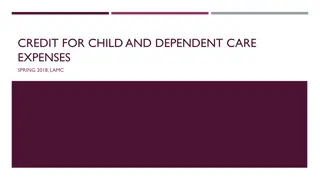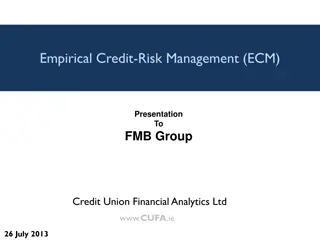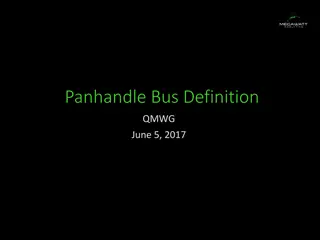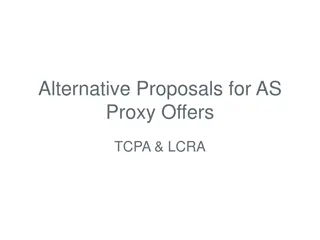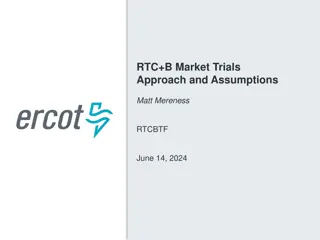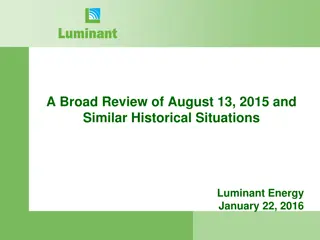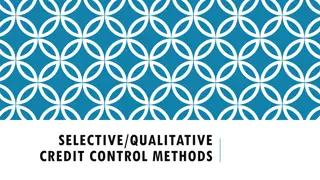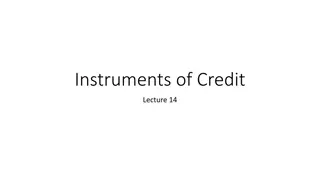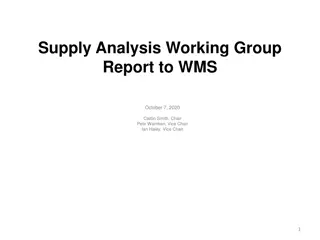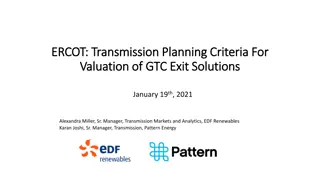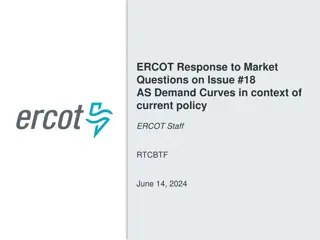ERCOT Market Credit Manager Proposal Analysis
This document outlines EAL change proposals scenarios for ERCOT Market Credit Manager, including definitions of invoice exposures, current EAL formulas, and various scenarios affecting the calculation. It covers invoice exposure definitions, current EAL formula versus scenarios #1, #1a, and #1b, as well as scenarios #2, #3, and #4. The proposals provide insights into handling invoice exposures, TPEA calculations, and adjustments based on specific market activities and timelines.
Uploaded on Sep 25, 2024 | 0 Views
Download Presentation

Please find below an Image/Link to download the presentation.
The content on the website is provided AS IS for your information and personal use only. It may not be sold, licensed, or shared on other websites without obtaining consent from the author. Download presentation by click this link. If you encounter any issues during the download, it is possible that the publisher has removed the file from their server.
E N D
Presentation Transcript
EAL Change Proposals Scenario #4 Sanchir Dashnyam ERCOT Market Credit Manager ERCOT Public May 17, 2024
Invoice Exposures Definitions Invoice exposures New M1 days forward invoices + 7 days look back actual invoices M1 days could range from 10 to 21 days depending on weekends/holidays, MP activity Invoices exclude M&N securitization invoices, CRR auction invoices and miscellaneous invoices relating to $2B distributed to market for Sec N on 6/21/22 Data is for a period covering 1/1/2022 through 2/29/24 TPEA excludes Uri invoices and PUL uplift TPEA Invoice exposures = Gap Negative gap is when invoice exposures exceed TPEA (less than -$10,000) Positive gap is when TPEA exceeds invoice exposures (more than $10,000) Independent amounts posted as a result of NPRR1165 are not included in these calculations. IA s are part of TPES. 2 ERCOT Public
Current EAL Formula vs. Scenarios #1, #1a and 1b Current: EAL q = Max [IEL during the first 40-day period only beginning on the date that the Counter-Party commences activity in ERCOT markets, RFAF * Max {RTLE during the previous lrq days}, RTLF] + DFAF * DALE + Max [RTLCNS, Max {URTA during the previous lrq days}] + OUT q + ILEq OUT q = OIA q + UDAA q + UFA q + UTA q + CARD Scenario #1: EAL t = Max [RFAF * Max { RTNLE during the previous lrt days}, FAF*RTNLF] + DFAF * DALE + Max [RTLCNS NLCD, Max {ULERTA during the previous lrq days}] + OUT (included UDAA) Use same RTM ODs for DAM as well NLF = net liability forward = 1.5 * NLCD NLCD = (7 most recent Operating days Real time estimates + 7 most recent DAM ODs day-ahead) if settled data is available use settled else estimates no price cap FAF = 21 future / most recent days 7 RTM Prices ULE = unbilled liability extrapolated (Last 14 days RTM Initial Statement Average + Last 14 days DAM Initial Statement Average based on RTM Initial OD)*M2 - use same RTM ODs for DAM as well NLE = Total net liability extrapolated (Last 14 days RTM Initial Statement Average + Last 14 days DAM Initial Statement Average based on RTM Initial OD)*M1. Scenario #1a: EAL = Max [RFAF * Max { RTNLE during the previous lrt days}, FAF*RTNLF] + DFAF * DALE + Max [RTLCNS (RTLCNS + UDAA), Max {ULERTA during the previous lrq days}] + OUT Scenario #1b EAL t = Max [RFAF * Max { RTNLE during the previous lrt days}, FAF*RTNLF] + DFAF * DALE + Max [RTLCNS NLCD, Max {ULERTA during the previous lrq days}] + OUT OUTt = OIA + UFA + UTA + CARD (S1a and S1b excludes UDAA) 3 ERCOT Public
Scenarios #2, #3 and #4 Scenario #2: EAL q = Max [IEL during the first 40-day period only beginning on the date that the Counter- Party commences activity in ERCOT markets, Max{(RFAF * Max {RTLE) during the previous lrq days}, RTLF] + DFAF * DALE + Max [RTLCNS, Max {URTA during the previous lrq days}] + OUT q + ILE q Scenario #3: EAL q = Max [IEL during the first 40-day period only beginning on the date that the Counter- Party commences activity in ERCOT markets, RFAF * Max {RTLE during the previous lrq days}, RTLF] + DFAF * DALE + Max [RTLCNS, Max {URTA during the previous lrq days}] + OUT q + ILE q Two RFAF s: CP specific RFAF and Global RFAF CP specific RFAF = Projected Real-Time ICE Forward Average Price / Max RTLE date Historic Real-Time Settled Average Price Global RFAF is calculated based on existing methodology. Global RFAF is used in MCE calculations. Scenario #4: Take Scenario #1a as a basis: EAL = Max [RFAF * Max { RTNLE*FAF during the previous lrt days}, FAF*RTNLF] + DFAF * DALE + Max [RTLCNS (RTLCNS + UDAA), Max {ULERTA during the previous lrq days}] + OUT Apply FAF against NLE, then take the Max and compare against FAF*NLF. Essentially combine Scenario #2 and Scenario #1 Establish a floor for FAF at 1 Increase MCE for load entities (2 days from 1 day) 4 ERCOT Public
TPEA for Scenarios market S4 patterns Scenario #4 results in the highest TPEA Due to netting, NLE now captures DAM exposures over the look back period. Max of FAF*NLE is driving the jump in EAL rather than FAF*NLF. This explains the difference in height or distance between S4 TPEA vs TPEAs for the rest of scenarios. Because of Max [{ NLE*FAF during the previous lrt days}, FAF*NLF] over the look back period, the peak endures and stays on until it rolls off. This explains the box or square shape of the TPEA for Scenario #4. 5 ERCOT Public
Negative and Positive Gaps: Market Market Negative Gap Current S1 S1a S1b S2 S3 S4 Sum total (26,070,059,192) $ (19,854,530,214) $ (23,829,446,729) $ (22,847,839,768) $ (23,482,396,074) $ (30,428,859,068) $ (10,287,524,653) $ Compared to Current # of occurences Compared to Current Average (1,668,911) $ (1,628,889) $ (1,733,681) $ (1,666,874) $ (1,553,171) $ (1,844,956) $ (1,104,404) $ Compared to Current 15,621 12,189 13,745 13,707 15,119 16,493 9,315 -23.8% -8.6% -12.4% -9.9% 16.7% -60.5% -22.0% -12.01% -12.25% -3.21% 5.58% -40.37% -2.4% 3.9% -0.1% -6.9% 10.5% -33.8% Positive Gap Current S1 S1a S1b S2 S3 S4 Sum total 904,684,735,541 $ 1,015,465,943,785 $ 988,039,296,169 $ 990,693,787,010 $ 895,355,289,874 $ 749,631,590,287 $ 1,449,595,662,472 $ Compared to Current # of occurences Compared to Current Average 3,494,111 $ 3,869,533 $ 3,794,270 $ 3,803,471 $ 3,451,799 $ 2,910,309 $ 5,440,016 $ Compared to Current 258,917 262,426 260,403 260,471 259,388 257,578 266,469 12.2% 9.2% 9.5% -1.0% -17.1% 60.2% 1.4% 0.6% 0.6% 0.18% -0.52% 2.92% 10.7% 8.6% 8.9% -1.2% -16.7% 55.7% S4 significantly decreases the negative gap events, however, it also increases positive gaps. 6 ERCOT Public
Negative Gaps: Winter storm Elliott Market Negative Gap Current S1 S1a S1b S2 S3 S4 Sum total (1,364,365,220) $ (1,873,205,907) $ (2,057,418,415) $ (2,041,252,455) $ (1,562,754,587) $ (1,461,985,971) $ (901,835,363) $ Compared to Current # of occurences Compared to Current Average (2,186,483) $ (3,263,425) $ (3,334,552) $ (3,271,238) $ (2,512,467) $ (2,328,003) $ (1,999,635) $ Compared to Current 624 574 617 624 622 628 451 37.3% 50.8% 49.6% 14.5% 7.2% -33.9% -8.0% -1.12% 0.00% -0.32% 0.64% -27.72% 49.3% 52.5% 49.6% 14.9% 6.5% -8.5% Positive Gap Current S1 S1a S1b S2 S3 S4 Sum total 23,611,721,153 $ 23,007,349,525 $ 22,060,976,405 $ 22,121,382,506 $ 23,581,493,580 $ 23,489,820,674 $ 28,340,417,243 $ Compared to Current # of occurences Compared to Current Average 2,441,750 $ 2,378,021 $ 2,288,958 $ 2,298,325 $ 2,438,372 $ 2,428,642 $ 2,887,460 $ Compared to Current 9,670 9,675 9,638 9,625 9,671 9,672 9,815 -2.6% -6.6% -6.3% -0.1% -0.5% 20.0% 0.1% -0.3% -0.5% 0.01% 0.02% 1.50% -2.6% -6.3% -5.9% -0.1% -0.5% 18.3% S4 decreases the negative gap events, however, it also increases positive gaps. 7 ERCOT Public
Negative Gaps: Winter storm Elliott by activity type Load & Gen Negative Gap Current S1 S1a S1b S2 S3 S4 Sum total (954,206,922) $ (1,505,578,521) $ (1,665,784,752) $ (1,640,653,929) $ (1,134,127,349) $ (1,043,478,991) $ (578,429,023) $ Compared to Current # of occurences Compared to Current Average (5,818,335) $ (10,528,521) $ (10,476,634) $ (10,517,012) $ (6,957,836) $ (6,286,018) $ (6,725,919) $ Compared to Current 164 143 159 156 163 166 86 57.8% 74.6% 71.9% 18.9% 9.4% -39.4% -12.8% -3.0% -4.9% -0.6% 1.2% -47.6% 81.0% 80.1% 80.8% 19.6% 8.0% 15.6% Load Negative Gap Current S1 S1a S1b S2 S3 S4 Sum total (333,890,985) $ (281,226,510) $ (304,563,961) $ (310,905,231) $ (350,412,645) $ (341,496,293) $ (244,903,125) $ Compared to Current # of occurences Compared to Current Average (1,094,725) $ (1,077,496) $ (1,046,612) $ (1,072,087) $ (1,134,022) $ (1,105,166) $ (1,144,407) $ Compared to Current 305 261 291 290 309 309 214 -15.8% -8.8% -6.9% 4.9% 2.3% -26.7% -14.4% -4.6% -4.9% 1.3% 1.3% -29.8% -1.6% -4.4% -2.1% 3.6% 1.0% 4.5% Traders Negative Gap Current S1 S1a S1b S2 S3 S4 Sum total (66,784,741) $ (81,606,824) $ (81,895,380) $ (84,057,463) $ (67,890,407) $ (66,909,126) $ (73,927,902) $ Compared to Current # of occurences Compared to Current Average (624,156) $ (618,234) $ (620,420) $ (591,954) $ (628,615) $ (625,319) $ (626,508) $ Compared to Current 107 132 132 142 108 107 118 22.2% 22.6% 25.9% 1.7% 0.2% 10.7% 23.4% 23.4% 32.7% 0.9% 0.0% 10.3% -0.9% -0.6% -5.2% 0.7% 0.2% 0.4% S4 Negative gaps increase for traders as compared to the rest. This is primarily due to netting. 8 ERCOT Public
Positive Gaps: Winter storm Elliott Load & Gen positive Gap Current S1 S1a S1b S2 S3 S4 Sum total 13,819,193,095 $ 14,225,993,140 $ 13,686,211,393 $ 13,724,648,904 $ 13,875,185,394 $ 13,905,072,574 $ 18,111,845,307 $ Compared to Current # of occurences Compared to Current Average 13,313,288 $ 13,652,585 $ 13,339,387 $ 13,337,851 $ 13,303,150 $ 13,383,130 $ 16,465,314 $ Compared to Current 1,038 1,042 1,026 1,029 1,043 1,039 1,100 2.9% -1.0% -0.7% 0.4% 0.6% 31.1% -0.4% 0.0% -1.5% -1.2% 0.1% -0.3% 2.5% 0.2% 0.2% -0.1% 0.5% 23.7% Load positive Gap Current S1 S1a S1b S2 S3 S4 Sum total 2,352,826,850 $ 2,244,107,502 $ 2,130,980,044 $ 2,148,570,786 $ 2,127,969,148 $ 2,158,224,823 $ 3,228,326,649 $ Compared to Current # of occurences Compared to Current Average 2,673,667 $ 2,428,688 $ 2,352,075 $ 2,371,491 $ 2,443,133 $ 2,463,727 $ 3,328,172 $ Compared to Current 880 924 906 906 871 876 970 -4.6% -9.4% -8.7% -9.6% -8.3% 37.2% 5.0% 3.0% 3.0% -1.0% -0.5% 10.2% -9.2% -3.2% 0.8% 3.0% 0.8% 35.1% Traders positive Gap Current S1 S1a S1b S2 S3 S4 Sum total 5,630,550,270 $ 4,830,841,368 $ 4,570,515,266 $ 4,575,005,014 $ 5,742,804,608 $ 5,629,453,456 $ 5,132,302,498 $ Compared to Current # of occurences Compared to Current Average 1,031,992 $ 891,793 $ 845,140 $ 848,166 $ 1,053,146 $ 1,031,791 $ 944,480 $ Compared to Current 5,456 5,417 5,408 5,394 5,453 5,456 5,434 -14.2% -18.8% -18.7% 2.0% 0.0% -8.8% -0.7% -0.9% -1.1% -0.1% 0.0% -0.4% -13.6% -18.1% -17.8% 2.0% 0.0% -8.5% S4 Positive gaps decrease for traders as compared to the rest which experienced an increase. This is primarily due to netting. 9 ERCOT Public
Sample trader during Winter Storm Elliott Days 1 2 3 4 Event Event +1 Event +6 RFAF*MaxRTLE DFAF*DALE minimal minimal minimal minimal FAF FAF FAF FAF FAF NLE NLF high high high high negative negative negative negative minimal minimal minimal minimal Large RTM invoice Captures Captures 10 ERCOT Public
Next steps: potential improvements/alternatives 1. Cap FAF as it is applied against NLE but not NLF, or, alternatively use a multiplier of 1.5 or 2.00 against NLE (instead of FAF). This is to have a floor but not too high of a floor, especially after the event. Reduce/adjust the look back period depending on seasons. This could help with the positive gaps. For NLE: Gross up/down charges/credits, similar to the treatment of RTLCNS. Essentially, increase exposures (charges) and discount the credits by 10%-20%. Currently for RTLCNS we are upping the charges and discounting the credits by 10% when coming up with the real time liability amount from the Real Time Imbalance Amount. 2. 3. 4. 5. For Traders, for NLE calculation do not net and take the positive (whether it is DA or RT), but do not apply a factor. For Traders, just leave it as is and do not apply any netting. 11 ERCOT Public






